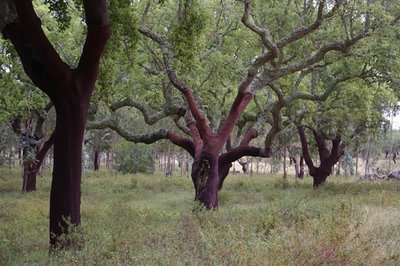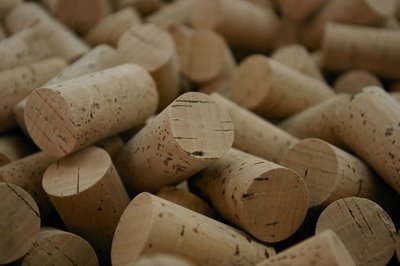Cork on TV: forest in a bottle
 Tonight there's a prime time national TV show all about cork. Titled Cork, forest in a bottle, it's focusing on the environmental impact of abandoning cork for alternative closures such as screwcaps and synthetic corks, and it will be shown at 9 pm tonight on BBC 2.
Tonight there's a prime time national TV show all about cork. Titled Cork, forest in a bottle, it's focusing on the environmental impact of abandoning cork for alternative closures such as screwcaps and synthetic corks, and it will be shown at 9 pm tonight on BBC 2.A quick recap on the issues surrounding corks and their alternatives. Cork is a wonderful natural product, which does a great job sealing wine bottles. It's only as we've moved away from cork to alternatives that we've found that the technical requirements of a wine bottle closure are not all that simple. What cork does (and this seems to be important), is to allow a slow release of oxygen from its compressed cellular structure for the first few months after bottling, and then a very low level of oxygen transmission from then on, through the cork/glass interface. The level of gas transmission by a sound cork seems to be just enough for optimum wine development, but not too much (in reality, it's hardly any at all).
But cork has a real problem: trichloroanisole (TCA) taint. 2,4,6-Trichloroanisole, the major compound responsible for musty taints associated with cork, is formed in cork bark by the chemical combination of phenolic compounds with chlorine. These phenolic compounds are naturally present in bark as a result of the breakdown of lignin, a hard substance giving bark its rigidity. The chlorine can come either from the environment, or from fungi living on or in the bark.
Weíre incredibly sensitive to TCA and its chemical relatives, and can detect them at very low concentrations. It makes wines taste and smell musty, like old cellars, or mouldy bread, or damp cardboard. Some people can detect TCA at concentrations as low as 2 ng/litre; others donít recognize it at 10 ng/litre.
Weíre incredibly sensitive to TCA and its chemical relatives, and can detect them at very low concentrations. It makes wines taste and smell musty, like old cellars, or mouldy bread, or damp cardboard. Some people can detect TCA at concentrations as low as 2 ng/litre; others donít recognize it at 10 ng/litre.

This makes life very hard for the cork industry. Thereís no easy way to spot a good cork from a bad one, and so winemakers have either had to resign themselves to losing a certain percentage of the wines they seal with cork to taint, or switch to cork alternatives such as screwcaps and synthetic corks. Many winemakers choose to remain with cork.
The good news for them is that the cork industry is responding to criticism and doing something about natural cork quality, trying to understand the causes of TCA and also to devise ways of removing it.
There are two rather different, yet complementary, approaches to dealing with TCA. The first is to use quality control measures to try to prevent contaminated cork from being turned into closures that then leave the factory. The second is to assume that TCA will be present, and to then remove it by some sort of extractive or washing method Ė the curative approach. Put both strategies together and substantial reductions can be obtained even if either strategy is not 100% effective alone.
The current rates of cork taint? About 3.3% - this is the figure from the International Wine Challenge faults clinic, which is the world's largest blind tasting, and includes wines from all over the world (this is the percantage of those bottles sealed with natural cork). It's likely that the rate was higher in the late 1980s and early 1990s, but the hope is that as the quality control measures and curative strategies that the leading cork companies have taken begin to show up in terms of lower taint levels, the rate of cork taint should drop to much lower levels.
It is largely because of the pressure put on cork companies by the success of alternative closures that these strategies have been put in place. Without alternative closures as competition, it is likely that we'd be stuck with much higher levels of cork taint. Winemakers have a responsibility to source cork only from those companies that are serious about combating taint.
The future? Cork is a wonderfully sustainable product with a low carbon footprint. The cork forests really are beautiful, and because wine stoppers are the most profitable use for cork, using cork this way sustains rural communities and helps preserve these ecosystems. But the wine industry can't take the hit that it was taking in terms of ruined bottles in the late 1990s all in the name of sustainability. If the rate of cork taint really is on the way down, then there's certainly a future for cork, but as just one of the closure solutions alongside a range of alternatives.
What has saved cork so far is that fact that sealing a wine bottle so that the wine tastes good when it's opened isn't a trivial matter of just 'sealing' it. If screwcaps, for instance, did exactly the same job as cork, then it would be stupid not to switch straight to screwcap for all wines: they don't have musty taint issues, and they are a lot more convenient because you don't need a device to open the bottle.
Labels: cork, cork taint


11 Comments:
And let's not forget random, or sporadic, oxidation from natural cork. This was the major reason for screwcap take up in my country.
The doc sounds interesting - I wonder how we can get a copy out here in the outer reaches of the galaxy.
Cheers
Paul
I think it's on at 8pm, at least in Scotland; it's just started.
Don't you think you should disclose how many cork producers have paid for how many of your trips to Portugal?
Anon
1 cork producer (Amorim) has paid for one trip to Portugal.
I have also visited the Diam factory near Badajoz, Spain.
I managed to miss that doc, but read about it... Sounded quite one-sided.
Is over-harvesting of cork a big problem? I know cork trees take decades to mature properly, and I wonder whether Europes cork forests can support the entire global wine industry. Overstretching the forests would surely be a bigger problem than competition from other closures, or even from TCA.
Thoughts?
Cheers
Will
Jamie
You are doing more, better, much more than, the most part of Portuguese bloggers or journalist. Thank you for that.
Off course that many producers will change for cheaper closers even if in the end the final price will be the same for the consumer...
In the end itís up the final consumers to make there decision. I still think that is more practical to have wine for cooking in a screw cap, but I never open a non cork bottle of wine for visits at home or a romantic dinner. And think also about the price of bottle of a top Bordeaux in a screw cap? Less 20 or 30%? Maybe more.
I thought the documentary was a fantastic travel feature about the Alentejo -all of it true, having experienced the Spring flowers and the bonelli eagles around Marvao -absolutely worth a visit. The cork part was pretty true too, acknowledging failures in the past and hi-lighting what's being done for the future. All was going well until the last thirty seconds, which seemed a bit mawkish and pleading. They'd done a good job up 'til that point,
I didn't see it (puppies were being born at the time) but it is repeated on Sunday evening, so I'll try to catch it then.
I really enjoyed reading your new featured article on cork. Very interesting to see how they are produced on what is being done to assure a high quality and to prevent TCA as good as possible.
Thank you for providing such a fine documentary, on such a dear theme for every portuguese.
It's probable it as been payed, and it should have. Portugal is the world's largest producer of cork and Amorim the largest producer of Portugal.
I will go even further than the bordeaux theme. Will you open a bottle of champagne with a screw cap?
Do you imagine every film in the world that envolves dinners with wine, having a sound of "click-click-click" instead of "pop"?
I don't. The I&D departments of some of our universty's have now fully understood TCA, and managed too eliminate it totally.
Let's hope that the cure, won't bring any flavour or modifications to the wine itself, but for that we need the future.
Beside being completely natural, and beautifull as a material (in London, for instance, go check on the washrooms of the Canteen restaurant by Sir Norman Foster) it's totally ignifugous and imperbeable, floating in water, and 100% recyclable.)
I have no interest in the cork industry nor have i got a montado. I just love it.
Tiago
Thank you for providing such a fine documentary, on such a dear theme for every portuguese.
It's probable it as been payed, and it should have. Portugal is the world's largest producer of cork and Amorim the largest producer of Portugal.
I will go even further than the bordeaux theme. Will you open a bottle of champagne with a screw cap?
Do you imagine every film in the world that envolves dinners with wine, having a sound of "click-click-click" instead of "pop"?
I don't. The I&D departments of some of our universty's have now fully understood TCA, and managed too eliminate it totally.
Let's hope that the cure, won't bring any flavour or modifications to the wine itself, but for that we need the future.
Beside being completely natural, and beautifull as a material (in London, for instance, go check on the washrooms of the Canteen restaurant by Sir Norman Foster) it's totally ignifugous and imperbeable, floating in water, and 100% recyclable.)
I have no interest in the cork industry nor have i got a montado. I just love it.
Tiago
Post a Comment
Links to this post:
Create a Link
<< Home